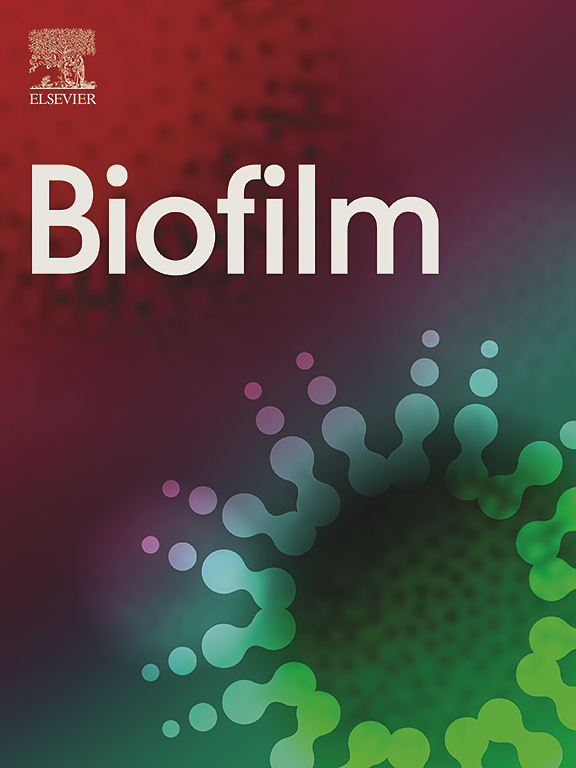Key bacterial vaginosis-associated bacteria influence each other's growth in biofilms in rich media and media simulating vaginal tract secretions
IF 4.9
Q1 MICROBIOLOGY
引用次数: 0
Abstract
Bacterial vaginosis (BV) is a very common gynaecologic condition affecting women of reproductive age worldwide. BV is characterized by a depletion of lactic acid-producing Lactobacillus species and an increase in strict and facultative anaerobic bacteria that develop a polymicrobial biofilm on the vaginal epithelium. Despite multiple decades of research, the etiology of this infection is still not clear. However, some BV-associated bacteria (BVAB) may play a key role in the development of this infection, namely Gardnerella species, Prevotella bivia, and Fannyhessea vaginae. In this work, we aimed to characterize the growth of these three species in a rich medium and in a medium simulating vaginal tract secretions (mGTS). We first assessed planktonic growth in New York City (NYCIII) medium and mGTS and observed that the three species showed distinct capacities to grow in the two media. Surprisingly, despite the ability of all three species to grow in single-species in NYCIII, in a triple-species consortium P. bivia was not able to increase its concentration after 48 h, as assessed by qPCR. Furthermore, when using the more restrictive mGTS media, G. vaginalis was the only BVAB able to grow in the triple-species consortia. Interestingly, we found that P. bivia growth in NYCIII was influenced by the cell-free supernatant (CFS) of F. vaginae and by the CFS of G. vaginalis in mGTS. This antimicrobial activity appears to happen due to the acidification of the media. Single- and triple-species biofilms were then formed, and the growth of each species was further quantified by qPCR. While G. vaginalis had a high capacity to form biofilms in both media, F. vaginae and P. bivia biofilm growth was favored when cultured in rich media. Differences were also found in the structure of triple-species biofilms formed in both media, as assessed by confocal laser scanning microscopy. In conclusion, while all three species were able to grow in single-species biofilms in rich media, in mGTS the growth of G. vaginalis was essential for incorporation of the other species in the biofilm.
在丰富介质和模拟阴道分泌物介质的生物膜中,阴道炎相关细菌相互影响生长。
细菌性阴道病(细菌性阴道病)是影响全世界育龄妇女的一种非常常见的妇科疾病。细菌性阴道炎的特征是产生乳酸的乳酸菌种类的减少和严格和兼性厌氧细菌的增加,这些细菌在阴道上皮上形成多微生物生物膜。尽管经过几十年的研究,这种感染的病因仍不清楚。然而,一些细菌性阴道炎相关细菌(BVAB)可能在这种感染的发展中起关键作用,即加德纳氏菌、bivia普雷沃氏菌和范尼赫西阴道菌。在这项工作中,我们的目的是表征这三个物种在富培养基和模拟阴道分泌物(mGTS)培养基中的生长。我们首先评估了纽约市(NYCIII)培养基和mGTS中的浮游生物生长情况,并观察到三种物种在两种培养基中表现出不同的生长能力。令人惊讶的是,尽管这三个物种在NYCIII中都能以单一物种的形式生长,但在三物种联合体中,P. bivia在48小时后不能增加其浓度,这是通过qPCR评估的。此外,当使用限制性更强的mGTS培养基时,G. vaginalis是唯一能够在三种菌群中生长的BVAB。有趣的是,我们发现pbivia在NYCIII中的生长受到阴道F.的无细胞上清(CFS)和mGTS中阴道G.的CFS的影响。这种抗菌活性似乎是由于培养基的酸化而发生的。然后形成单种和三种生物膜,并通过qPCR进一步量化每种生物的生长情况。阴道弧菌在两种培养基中均具有较高的生物膜形成能力,而阴道弧菌和bivia弧菌在富培养基中更有利于生物膜的生长。通过共聚焦激光扫描显微镜评估,两种培养基中形成的三种生物膜的结构也存在差异。综上所述,虽然这三个菌种都能在富培养基的单菌种生物膜中生长,但在mGTS中,阴道梭菌的生长对其他菌种融入生物膜至关重要。
本文章由计算机程序翻译,如有差异,请以英文原文为准。
求助全文
约1分钟内获得全文
求助全文

 求助内容:
求助内容: 应助结果提醒方式:
应助结果提醒方式:


